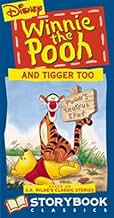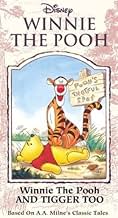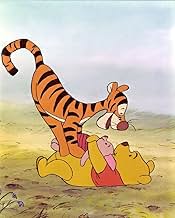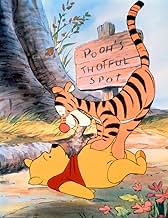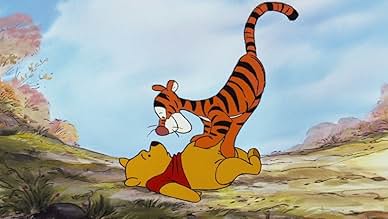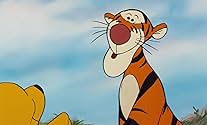CALIFICACIÓN DE IMDb
7.8/10
3.1 k
TU CALIFICACIÓN
Conejo está cansado de que Tigger siempre lo haga rebotar, así que reúne a Pooh y Piglet para pensar en una idea para que Tigger deje de rebotar. Conejo sugiere que lo lleven al medio de la ... Leer todoConejo está cansado de que Tigger siempre lo haga rebotar, así que reúne a Pooh y Piglet para pensar en una idea para que Tigger deje de rebotar. Conejo sugiere que lo lleven al medio de la nada y lo dejen allí toda la noche.Conejo está cansado de que Tigger siempre lo haga rebotar, así que reúne a Pooh y Piglet para pensar en una idea para que Tigger deje de rebotar. Conejo sugiere que lo lleven al medio de la nada y lo dejen allí toda la noche.
- Dirección
- Guionistas
- Elenco
- Nominado a 1 premio Óscar
- 1 premio ganado y 1 nominación en total
Opiniones destacadas
This is a great cartoon short with lots of (almost) everybody's favorite, Tigger. Rabbit is tired of Tigger bouncing on him so he comes up with a plan to stop it. It backfires and he winds up having to be rescued by Tigger. Later, when Tigger is stuck up a tree, he makes a promise to never bounce again if he is saved. But can Tigger possibly keep such a promise? Will his friends even expect him to? This is another Pooh classic. Some great animation and wonderful voicework, especially by Paul Winchell as Tigger. A sweet, memorable, fun cartoon with terrific characters and lots of heart. Great for kids but for adults as well.
I have watched and reviewed a ton of Academy Award nominated animated shorts and this is a rare situation where I saw two films in this category in the same year that I think earned a 10--one of which was this wonderful film from Disney. The other, CLOSED MONDAYS, I loved because of its amazingly cranky main character and the uniqueness (at the time) of Claymation. Both are great and worth seeing, though I can't help but prefer WINNIE THE POOH AND TIGGER TOO!--it just had a timeless magical quality about it.
However, I can certainly understand the Oscar people not giving this Pooh film an Oscar--after all, in 1969, WINNIE THE POOH AND THE BLUSTERY DAY earned the award in this category, so it wasn't like this Tigger film was super-unique--which CLOSED MONDAYS certainly was.
As for this film, it is available now in a DVD with several other early Pooh shorts and is a must-have for fans of Pooh. It is simply perfect--charming and expertly crafted--with some of the best Disney animation you'll ever see.
However, I can certainly understand the Oscar people not giving this Pooh film an Oscar--after all, in 1969, WINNIE THE POOH AND THE BLUSTERY DAY earned the award in this category, so it wasn't like this Tigger film was super-unique--which CLOSED MONDAYS certainly was.
As for this film, it is available now in a DVD with several other early Pooh shorts and is a must-have for fans of Pooh. It is simply perfect--charming and expertly crafted--with some of the best Disney animation you'll ever see.
This is the third short of Winnie the Pooh and his friends. In my opinion, it's the funniest of all and just as good as the earlier 2 shorts. This one isn't simply the funniest, it is also the bounciest. This is full of classic humor and great fun! Yes, our friend Tigger bounces a lot here. He's full of surprises and he bounces to his friends when they less expect. He bounces to Winnie the Pooh, Piglet and Rabbit. He surprises Pooh, scares Piglet, angers Rabbit and amuses little Roo and Kanga. However, he does a special "small bouncing" for Piglet because he is so tiny and he doesn't really bounce to Roo or Kanga, perhaps in respect for Kanga.
And oh, it's so delightful to hear Tigger amusingly saying «Hi hi! She called me dear!» - there's also some vanity in the way he says it. It's equally delightful to hear Tigger calling Pooh «the one who's stuffed with fluff» and «very comfy, too», as well as to hear him call "Long ears" to Rabbit.
Rabbit, of course, likes Tigger as much as the others, but he doesn't accept very well Tigger's bounces. In fact, he decides to have a meeting of protest with Pooh and Piglet because he has a plan to "unbounce" Tigger. The plan consists in taking Tigger to the forest and leave him alone in a far place, so that he gets lost and stops bouncing.
But the plan doesn't work the way they expect. Ironically, Rabbit, Pooh and Piglet are the ones who get lost and Tigger ends up finding them and bounces them, one by one. However, Rabbit is the one who feels humiliated after Tigger assures that «Tiggers never get lost» and keeps wondering «Why oh why oh why?». Tigger is just too smart to get lost.
Later, Tigger decides to take Roo with him to teach him all about bouncing. Tigger gets overexcited, bounces until the top of a tree and that's when something hilarious happens: Tigger is too afraid of heights, so much that he doesn't have courage to even try to get out of that sticky situation. He even promises not to bounce anymore (without really meaning it, of course). It's so hilarious to see our friend Tigger scared of heights.
These Winnie the Pooh's old shorts are real classics. Timeless and very charming. They also give us that "nostalgia" feeling about childhood and classic Disney. In Tigger's words, instead of a goodbye, I'll just say «Halloo!» :)
And oh, it's so delightful to hear Tigger amusingly saying «Hi hi! She called me dear!» - there's also some vanity in the way he says it. It's equally delightful to hear Tigger calling Pooh «the one who's stuffed with fluff» and «very comfy, too», as well as to hear him call "Long ears" to Rabbit.
Rabbit, of course, likes Tigger as much as the others, but he doesn't accept very well Tigger's bounces. In fact, he decides to have a meeting of protest with Pooh and Piglet because he has a plan to "unbounce" Tigger. The plan consists in taking Tigger to the forest and leave him alone in a far place, so that he gets lost and stops bouncing.
But the plan doesn't work the way they expect. Ironically, Rabbit, Pooh and Piglet are the ones who get lost and Tigger ends up finding them and bounces them, one by one. However, Rabbit is the one who feels humiliated after Tigger assures that «Tiggers never get lost» and keeps wondering «Why oh why oh why?». Tigger is just too smart to get lost.
Later, Tigger decides to take Roo with him to teach him all about bouncing. Tigger gets overexcited, bounces until the top of a tree and that's when something hilarious happens: Tigger is too afraid of heights, so much that he doesn't have courage to even try to get out of that sticky situation. He even promises not to bounce anymore (without really meaning it, of course). It's so hilarious to see our friend Tigger scared of heights.
These Winnie the Pooh's old shorts are real classics. Timeless and very charming. They also give us that "nostalgia" feeling about childhood and classic Disney. In Tigger's words, instead of a goodbye, I'll just say «Halloo!» :)
10llltdesq
Disney has been criticized (often justifiably) for the sometimes very loose adaptations of other works to animation. But they generally have done quite well by the Winnie-the-Pooh adaptations. This short, nominated for an Academy Award in the excellent year of 1974, is a first-class adaptation of the denizens of the 100-Acre Wood. Personally, Tigger is my second favorite character (after Eeyore) so I particularly like this one. Disney used animation to actually create the feel of the A.A. Milne books and did very well by the stories. Highly Recommended.
This was the third 'act' of The Many Adventures of Winnie the Pooh, which is how I first saw this as a very young child (probably a baby, now that I think about it). Though the whole feature was kind of ingrained into my system at an early age, I think this final section always left an impression on me. It was because of Tigger being this main subject here - in later years he'd get his own movie, The Tigger Movie as it was pretty obviously called - though really moreso about how he was perceived, that made it so funny and captivating and even a couple of times scary and almost-borderline sad.
The two things that happen in Winnie the Pooh and Tigger Too involve Rabbit in a big way, and it's little wonder from a storytelling perspective; they're diametrically opposed, with Tigger and his, to put it lightly, carefree attitude, and Rabbit being, to also put it mildly, fastidious. He likes his garden and Tiggers bouncy ways mess it up. Can the bounce go away for a while? A personality adjustment could do it, so he, Pooh and Piglet go out into the woods with the plan to abandon him (just for the night, as Rabbit proposes to a hilariously sleepy Pooh by the way), but it backfires as Rabbit is the one who gets stuck (not unlike, say, Snow White in her feature).
The other thing is that Tigger does get some emotional shock when he is stuck up high on a tree - he even talks to the Narrator Sebastian Cabot, which I found both young and today absolutely hysterical - and maybe does, just for a moment question or lose his bounce (by, you know, 'request' of a sort). This second part may not be completely as masterful as the first segment, but the two compliment each other and work together as two stories in one whole: what does it mean for other people around Tigger? Or just Rabbit, for that matter? If all you do is bounce around and have fun, is it fun for everyone else around you, or will some people not 'get' it, or completely match up to that fun (ala Roo, if memory serves).
Ultimately, as it's shown, being 'bouncy' is a good thing, certainly if one is a Tigger. But what I've always liked about these stories here is that it's actually not Pooh challenging the springy fella, it's the character who we probably shouldn't stand really, the 'grown up' curmudgeon guy. Maybe some day kids will have to stop bouncing, but for now, it's alright, and certainly for comedy sake, that is.
The two things that happen in Winnie the Pooh and Tigger Too involve Rabbit in a big way, and it's little wonder from a storytelling perspective; they're diametrically opposed, with Tigger and his, to put it lightly, carefree attitude, and Rabbit being, to also put it mildly, fastidious. He likes his garden and Tiggers bouncy ways mess it up. Can the bounce go away for a while? A personality adjustment could do it, so he, Pooh and Piglet go out into the woods with the plan to abandon him (just for the night, as Rabbit proposes to a hilariously sleepy Pooh by the way), but it backfires as Rabbit is the one who gets stuck (not unlike, say, Snow White in her feature).
The other thing is that Tigger does get some emotional shock when he is stuck up high on a tree - he even talks to the Narrator Sebastian Cabot, which I found both young and today absolutely hysterical - and maybe does, just for a moment question or lose his bounce (by, you know, 'request' of a sort). This second part may not be completely as masterful as the first segment, but the two compliment each other and work together as two stories in one whole: what does it mean for other people around Tigger? Or just Rabbit, for that matter? If all you do is bounce around and have fun, is it fun for everyone else around you, or will some people not 'get' it, or completely match up to that fun (ala Roo, if memory serves).
Ultimately, as it's shown, being 'bouncy' is a good thing, certainly if one is a Tigger. But what I've always liked about these stories here is that it's actually not Pooh challenging the springy fella, it's the character who we probably shouldn't stand really, the 'grown up' curmudgeon guy. Maybe some day kids will have to stop bouncing, but for now, it's alright, and certainly for comedy sake, that is.
¿Sabías que…?
- TriviaThis featurette accompanied the theatrical release of The Island at the Top of the World (1974).
- ErroresAfter Piglet, Pooh, and Rabbit lose Tigger in the mist, the surroundings of the sand pit on page 123 are the fallen tree and little trees. Then when Piglet, Pooh, and Rabbit return to the sand pit, there are more bigger trees and bushes within the pit's surroundings and there's a bigger tree where the fallen tree was.
- Créditos curiososThere are no end credits at the end of this feature. All credits are at the beginning of the feature.
- Versiones alternativasAn airing on NBC circa 1975 had a sped up intro that contained male voiceover whom announced the title and a sponsorship from Sears which was in charge of Winnie the Pooh merchandise at the time. The 1986 VHS release and 1987 laserdisc release had this same variant except for fading to black for about a nanosecond after the title when the sponsorship was announced on TV which meant that the sponsorship was cut from the 1986 VHS release and 1987 laserdisc release.
- ConexionesEdited into Las aventuras de Winnie Pooh (1977)
- Bandas sonorasThe Wonderful Thing About Tiggers
Music and Lyrics by Richard M. Sherman and Robert B. Sherman
Performed by Paul Winchell
Selecciones populares
Inicia sesión para calificar y agrega a la lista de videos para obtener recomendaciones personalizadas
Detalles
- Fecha de lanzamiento
- País de origen
- Idioma
- También se conoce como
- Winnie the Pooh and Tigger Too
- Locaciones de filmación
- Productoras
- Ver más créditos de la compañía en IMDbPro
- Tiempo de ejecución
- 25min
- Relación de aspecto
- 1.37 : 1
Contribuir a esta página
Sugiere una edición o agrega el contenido que falta

